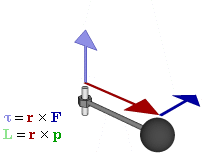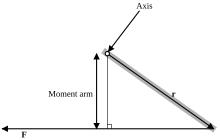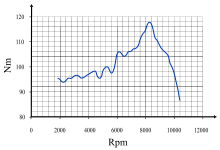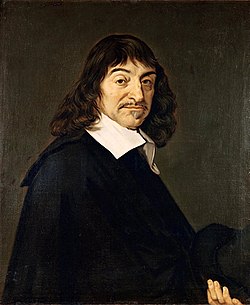| Torque | |
|---|---|
Common symbols
|
 , M , M |
| SI unit | N⋅m |

Relationship between force F, torque τ, linear momentum p, and angular momentum L in a system which has rotation constrained in one plane only (forces and moments due to gravity and friction not considered).
Torque, moment, or moment of force is rotational force.[1] Just as a linear force is a push or a pull, a torque can be thought of as a twist to an object. In three dimensions, the torque is a pseudovector; for point particles, it is given by the cross product of the position vector (distance vector) and the force vector.
The symbol for torque is typically
 , the lowercase Greek letter tau. When it is called moment of force, it is commonly denoted by M.
, the lowercase Greek letter tau. When it is called moment of force, it is commonly denoted by M.The magnitude of torque of a rigid body depends on three quantities: the force applied, the lever arm vector[2] connecting the origin to the point of force application, and the angle between the force and lever arm vectors. In symbols:
is the torque vector and
is the magnitude of the torque,
- r is the position vector (a vector from the origin of the coordinate system defined to the point where the force is applied)
- F is the force vector,
- × denotes the cross product,which is defined as magnitudes of the respective vectors times sin θ.
- θ is the angle between the force vector and the lever arm vector.
Defining terminology
Torque is referred to using different vocabulary depending on geographical location and field of study. This article refers to the definition used in US physics in its usage of the word torque.[3] In the UK and in US mechanical engineering, torque is referred to as moment of force, usually shortened to moment.[4] In US physics[3] and UK physics terminology these terms are interchangeable, unlike in US mechanical engineering, where the term torque is used for the closely related "resultant moment of a couple".[4]Torque is defined mathematically as the rate of change of angular momentum of an object. The definition of torque states that one or both of the angular velocity or the moment of inertia of an object are changing. Moment is the general term used for the tendency of one or more applied forces to rotate an object about an axis, but not necessarily to change the angular momentum of the object (the concept which is called torque in physics).[4] For example, a rotational force applied to a shaft causing acceleration, such as a drill bit accelerating from rest, results in a moment called a torque. By contrast, a lateral force on a beam produces a moment (called a bending moment), but since the angular momentum of the beam is not changing, this bending moment is not called a torque. Similarly with any force couple on an object that has no change to its angular momentum, such moment is also not called a torque.
This article follows the US physics terminology by calling all moments by the term torque, whether or not they cause the angular momentum of an object to change.
History
The concept of torque, also called moment or couple, originated with the studies of Archimedes on levers. The term torque was apparently introduced into English scientific literature by James Thomson, the brother of Lord Kelvin, in 1884.[5]Definition and relation to angular momentum
A particle is located at position r relative to its axis of rotation. When a force F is applied to the particle, only the perpendicular component F⊥ produces a torque. This torque τ = r × F has magnitude τ = |r| |F⊥| = |r| |F| sin θ and is directed outward from the page.
A force applied at a right angle to a lever multiplied by its distance from the lever's fulcrum (the length of the lever arm) is its torque. A force of three newtons applied two metres from the fulcrum, for example, exerts the same torque as a force of one newton applied six metres from the fulcrum. The direction of the torque can be determined by using the right hand grip rule: if the fingers of the right hand are curled from the direction of the lever arm to the direction of the force, then the thumb points in the direction of the torque.[6]
More generally, the torque on a particle (which has the position r in some reference frame) can be defined as the cross product:
It follows from the properties of the cross product that the torque vector is perpendicular to both the position and force vectors. The torque vector points along the axis of the rotation that the force vector (starting from rest) would initiate. The resulting torque vector direction is determined by the right-hand rule.[7]
The unbalanced torque on a body along axis of rotation determines the rate of change of the body's angular momentum,
where α is the angular acceleration of the particle, and p|| is the radial component of its linear momentum. This equation is the rotational analogue of Newton's Second Law for point particles, and is valid for any type of trajectory. Note that although force and acceleration are always parallel and directly proportional, the torque τ need not be parallel or directly proportional to the angular acceleration α. This arises from the fact that although mass is always conserved, the moment of inertia in general is not.
Proof of the equivalence of definitions
The definition of angular momentum for a single particle is: (whether or not mass is constant) and the definition of velocity
(whether or not mass is constant) and the definition of velocity 
 with its associated velocity
with its associated velocity  is zero because velocity and momentum are parallel, so the second term vanishes.
is zero because velocity and momentum are parallel, so the second term vanishes.By definition, torque τ = r × F. Therefore, torque on a particle is equal to the first derivative of its angular momentum with respect to time.
If multiple forces are applied, Newton's second law instead reads Fnet = ma, and it follows that
Units
Torque has dimension force times distance, symbolically L2MT−2. Official SI literature suggests using the unit newton metre (N⋅m) or the unit joule per radian.[9] The unit newton metre is properly denoted N⋅m or N m.[10] This avoids ambiguity with mN, millinewtons.The SI unit for energy or work is the joule. It is dimensionally equivalent to a force of one newton acting over a distance of one metre, but it is not used for torque. Energy and torque are entirely different concepts, so the practice of using different unit names (i.e., reserving newton metres for torque and using only joules for energy) helps avoid mistakes and misunderstandings.[9] The dimensional equivalence of these units is not simply a coincidence: a torque of 1 N⋅m applied through a full revolution will require an energy of exactly 2π joules. Mathematically,
In Imperial units, "pound-force-feet" (lbf⋅ft), "foot-pounds-force", "inch-pounds-force", "ounce-force-inches" (ozf⋅in)[citation needed] are used, and other non-SI units of torque includes "metre-kilograms-force". For all these units, the word "force" is often left out.[11] For example, abbreviating "pound-force-foot" to simply "pound-foot" (in this case, it would be implicit that the "pound" is pound-force and not pound-mass). This is an example of the confusion caused by the use of English units that may be avoided with SI units because of the careful distinction in SI between force (in newtons) and mass (in kilograms).
Torque is sometimes listed with units that do not make dimensional sense, such as the gram-centimeter. In this case, "gram" should be understood as the force given by the weight of 1 gram on the surface of the Earth (i.e. 0.00980665 N). The surface of the Earth has a standard gravitational field strength of 9.80665 N/kg.
Special cases and other facts
Moment arm formula
Moment arm diagram
A very useful special case, often given as the definition of torque in fields other than physics, is as follows:
The torque caused by the two opposing forces Fg and −Fg causes a change in the angular momentum L in the direction of that torque. This causes the top to precess.
Static equilibrium
For an object to be in static equilibrium, not only must the sum of the forces be zero, but also the sum of the torques (moments) about any point. For a two-dimensional situation with horizontal and vertical forces, the sum of the forces requirement is two equations: ΣH = 0 and ΣV = 0, and the torque a third equation: Στ = 0. That is, to solve statically determinate equilibrium problems in two-dimensions, three equations are used.Net force versus torque
When the net force on the system is zero, the torque measured from any point in space is the same. For example, the torque on a current-carrying loop in a uniform magnetic field is the same regardless of your point of reference. If the net force is not zero, and
is not zero, and  is the torque measured from
is the torque measured from  , then the torque measured from
, then the torque measured from  is …
is … 
Machine torque
Torque curve of a motorcycle ("BMW K 1200 R 2005"). The horizontal axis is the speed (in rpm) that the crankshaft is turning, and the vertical axis is the torque (in newton metres) that the engine is capable of providing at that speed.
Torque is part of the basic specification of an engine: the power output of an engine is expressed as its torque multiplied by its rotational speed of the axis. Internal-combustion engines produce useful torque only over a limited range of rotational speeds (typically from around 1,000–6,000 rpm for a small car). The varying torque output over that range can be measured with a dynamometer, and shown as a torque curve.
Steam engines and electric motors tend to produce maximum torque close to zero rpm, with the torque diminishing as rotational speed rises (due to increasing friction and other constraints). Reciprocating steam engines can start heavy loads from zero RPM without a clutch.
Relationship between torque, power, and energy
If a force is allowed to act through a distance, it is doing mechanical work. Similarly, if torque is allowed to act through a rotational distance, it is doing work. Mathematically, for rotation about a fixed axis through the center of mass,Proof
The work done by a variable force acting over a finite linear displacement is given by integrating the force with respect to an elemental linear displacement
is given by integrating the force with respect to an elemental linear displacement 
 is related to a corresponding angular displacement
is related to a corresponding angular displacement  and the radius vector
and the radius vector  as
as is a scalar triple product given by
is a scalar triple product given by ![{\displaystyle \left[{\vec {F}}\,\mathrm {d} {\vec {\theta }}\,{\vec {r}}\right]}](https://wikimedia.org/api/rest_v1/media/math/render/svg/72ea8287e337fb698bb2ddfb0924b4a3412bc2ee) . An alternate expression for the same scalar triple product is
. An alternate expression for the same scalar triple product is giving
givingPower is the work per unit time, given by
Algebraically, the equation may be rearranged to compute torque for a given angular speed and power output. Note that the power injected by the torque depends only on the instantaneous angular speed – not on whether the angular speed increases, decreases, or remains constant while the torque is being applied (this is equivalent to the linear case where the power injected by a force depends only on the instantaneous speed – not on the resulting acceleration, if any).
In practice, this relationship can be observed in bicycles: Bicycles are typically composed of two road wheels, front and rear gears (referred to as sprockets) meshing with a circular chain, and a derailleur mechanism if the bicycle's transmission system allows multiple gear ratios to be used (i.e. multi-speed bicycle), all of which attached to the frame. A cyclist, the person who rides the bicycle, provides the input power by turning pedals, thereby cranking the front sprocket (commonly referred to as chainring). The input power provided by the cyclist is equal to the product of cadence (i.e. the number of pedal revolutions per minute) and the torque on spindle of the bicycle's crankset. The bicycle's drivetrain transmits the input power to the road wheel, which in turn conveys the received power to the road as the output power of the bicycle. Depending on the gear ratio of the bicycle, a (torque, rpm)input pair is converted to a (torque, rpm)output pair. By using a larger rear gear, or by switching to a lower gear in multi-speed bicycles, angular speed of the road wheels is decreased while the torque is increased, product of which (i.e. power) does not change.
Consistent units must be used. For metric SI units, power is watts, torque is newton metres and angular speed is radians per second (not rpm and not revolutions per second).
Also, the unit newton metre is dimensionally equivalent to the joule, which is the unit of energy. However, in the case of torque, the unit is assigned to a vector, whereas for energy, it is assigned to a scalar.
Conversion to other units
A conversion factor may be necessary when using different units of power or torque. For example, if rotational speed (revolutions per time) is used in place of angular speed (radians per time), we multiply by a factor of 2π radians per revolution. In the following formulas, P is power, τ is torque, and ν (Greek letter nu) is rotational speed.Some people (e.g., American automotive engineers) use horsepower (imperial mechanical) for power, foot-pounds (lbf⋅ft) for torque and rpm for rotational speed. This results in the formula changing to:
Use of other units (e.g., BTU per hour for power) would require a different custom conversion factor.
Derivation
For a rotating object, the linear distance covered at the circumference of rotation is the product of the radius with the angle covered. That is: linear distance = radius × angular distance. And by definition, linear distance = linear speed × time = radius × angular speed × time.By the definition of torque: torque = radius × force. We can rearrange this to determine force = torque ÷ radius. These two values can be substituted into the definition of power:
























![{\displaystyle \left[{\vec {F}}\,\mathrm {d} {\vec {\theta }}\,{\vec {r}}\right]={\vec {r}}\times {\vec {F}}\cdot \mathrm {d} {\vec {\theta }}}](https://wikimedia.org/api/rest_v1/media/math/render/svg/cba9665fa7924628717ae3ee0d34658b239529b6)










![{\displaystyle {\begin{aligned}{\text{power}}&={\frac {{\text{force}}\cdot {\text{linear distance}}}{\text{time}}}\\[6pt]&={\frac {\left({\dfrac {\text{torque}}{r}}\right)\cdot (r\cdot {\text{angular speed}}\cdot t)}{t}}\\[6pt]&={\text{torque}}\cdot {\text{angular speed}}.\end{aligned}}}](https://wikimedia.org/api/rest_v1/media/math/render/svg/4382d186e4085de735546ad46847d852af843fcb)

![{\displaystyle {\begin{aligned}{\text{power}}&={\text{torque}}\cdot 2\pi \cdot {\text{rotational speed}}\cdot {\frac {{\text{ft}}\cdot {\text{lbf}}}{\text{min}}}\cdot {\frac {\text{horsepower}}{33,000\cdot {\frac {{\text{ft}}\cdot {\text{lbf}}}{\text{min}}}}}\\[6pt]&\approx {\frac {{\text{torque}}\cdot {\text{RPM}}}{5,252}}\end{aligned}}}](https://wikimedia.org/api/rest_v1/media/math/render/svg/5de129cd918c8164ddc724a5ce9efb6d86fc7208)

